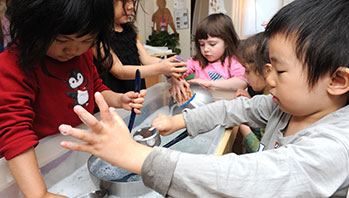- two plastic bins labeled with signs: Float and Sink
- objects that float or sink
- collection of balls that float or sink (ping pong ball, foam ball, golf ball, tennis ball, rubber ball, marble, whiffle ball, balled-up piece of aluminum foil, lacrosse ball, bocce ball)
- chart paper
- marker
- paper and crayons
- paper towels (for spills)
- camera or cellphone with camera
- absorb
- float
- sink
MA Standards:
Language/L.PK.MA.6: Use words and phrases acquired through conversations, listening to books read aloud, activities, and play.
MA Draft STE Standards:
Physical Sciences/Matter and Its Interactions: Structure and Properties of Matter/PS1.A: Describe, compare, sort and classify objects based on observable physical characteristics, uses, and whether it is manufactured as part of their classroom play and investigations of the natural and human-made world.
Head Start Outcomes:
Logic and Reasoning/Reasoning and Problem Solving: Classifies, compares, and contrasts objects, events, and experiences.
Science Knowledge/Scientific Skills and Method: Observes and discusses common properties, differences, and comparisons among objects.
Science Knowledge/Scientific Skills and Method: Collects, describes, and records information through discussions, drawings, maps, and charts.
Science Knowledge/Scientific Skills and Method: Describes and discusses predictions, explanations, and generalizations based on past experience.
Science Knowledge/Conceptual Knowledge of Natural and Physical Worlds: Observes, describes, and discusses properties of materials and transformation of substances.
PreK Learning Guidelines:
English Language Arts/Language 2: Participate actively in discussions, listen to the ideas of others, and ask and answer relevant questions.
Science and Technology/Earth and Space Sciences 5: Compare and contrast natural materials such as water, rocks, soil, and living organisms using descriptive language.
Science and Technology/Physical Sciences 19: Explore, describe, and compare the properties of liquids and solids found in children's daily environment.
Explore Together (indoors): Balls: Float or Sink?

© Commonwealth of Massachusetts, Department of Early Education and Care (Jennifer Waddell photographer). All rights reserved.
STEM Key Concepts: Objects behave differently in water; Some things float; Some things sink; If you add enough weight to a floating object, it will sometimes sink; Solids have physical characteristics that can be observed and described
ELA Focus Skills: Compare and Contrast, Follow Directions, Listening and Speaking, Vocabulary
Tell children they are going to continue to explore things that float or sink. Prompt children to test their ball predictions. Place the prediction chart and the balls near the water area. Invite children to test the group predictions and record what happens on the chart. You may need to be available for dictation. As children explore, circulate and observe, listen to, and engage with children. Draw their attention to the characteristics of objects and what they do in water. Ask questions such as,
- What happens when you push the sponge ball to the bottom of the water and then let it go?
- Do all the balls or objects that float keep floating, or do some gradually sink to the bottom? Why do you think that happens?
- If needed, explain how some objects absorb—or soak up—water. Say, Some objects start out floating, but as they fill with, or absorb water they gradually sink to the bottom.
Encourage children to sort the objects into the labeled Float and Sink bins as they explore. This will make it easier for them to identify characteristics that are similar or different among the objects. Take photos of children’s observations to refer to throughout the week.
Reflect and Share
Allow time for children to share their floating and sinking observations. Use any photos or videos to help children describe their ideas. Then present the chart to the group. Compare the group predictions to the results. Ask questions such as,
- Were any results surprising?
- Why do you think some objects start out floating and then sink?
- What is different about the balls that float and the balls that sink?
- Why do you think some balls sink fast and others sink slowly?
Adaptation: If the weather is warm, you may want to bring the materials outside. You can wheel the table outside, fill the containers outside, or fill a plastic pool with water. Then do the activity without worrying about spills.
Adaptation: For groups with numerous children, you may want to have two bins for children to explore. One bin has the balls and the chart; another bin has other objects that float or sink. Split the discovery time so each group gets to explore both areas.
Adaptation: You might prefer to have very young children do the activity individually, with one-to-one supervision.
English Language Learners: Point to and name each kind of ball. Have children hold each ball and describe it using the name of the ball in the sentence, such as The whiffle ball is light with lots of holes. The lacrosse ball is smooth and heavy.
